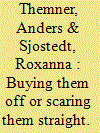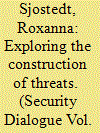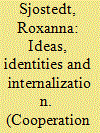| Srl | Item |
| 1 |
ID:
171219


|
|
|
|
|
| Summary/Abstract |
Post–civil war democracies are characterized by intense electoral competition. To ensure continued political relevance, ex-military-turned-politicians, or “warlord democrats” (WDs), can either engage in a rhetoric of fear or ease societal tensions by employing a rhetoric of peace. WDs’ choice of rhetoric can have a profound impact on durable peace by altering societal discourses concerning the legitimacy of using violence. A key question is therefore: Why do some WDs employ a rhetoric of fear, and others a rhetoric of peace, when running for office? We argue that the choice of rhetoric is a function of the patrimonial endowments WDs possess; if WDs lack the resources and social networks needed to distribute patronage, they may instead use a rhetoric of fear to rally voters. To highlight the explanatory value of this proposition, we compare two Liberian WDs who ran for the Senate in 2005—Adolphus Dolo and Prince Johnson.
|
|
|
|
|
|
|
|
|
|
|
|
|
|
|
|
| 2 |
ID:
060819


|
|
|
| 3 |
ID:
080870


|
|
|
|
|
| Publication |
2008.
|
| Summary/Abstract |
In April 2006, Russian President Vladimir Putin publicly declared HIV/AIDS to be a threat to Russia's national security and proposed a guiding strategy to handle it. This move stood in sharp contrast to previous policies of the Russian government. Despite the fact that Russia has experienced one of the fastest growing rates of HIV/AIDS in the world since the turn of the millennium, the government's involvement had previously been minimal, not recognizing AIDS as a national security threat. The question then arises: when is a threat really threatening? This article contributes to the development of theories on threat-framing and security decisionmaking by suggesting an analytical framework that incorporates explanatory variables from different levels of analysis. The adoption of a broad theoretical position facilitates a comprehensive understanding of time and space variations in the securitization of issues. The article demonstrates that norms and identity constructions at the international and domestic levels, combined with their internalization by individual decisionmakers, can together explain Putin's move, and that these factors are of different importance at difference stages of the threat-construction process
|
|
|
|
|
|
|
|
|
|
|
|
|
|
|
|
| 4 |
ID:
119234


|
|
|
|
|
| Publication |
2013.
|
| Summary/Abstract |
Why do some events take precedence over others in terms of being viewed as security issues? This article argues that in order to answer this question it is necessary to move beyond the assumption that threat images are self-evident. Rather, a distinction should be made between the contextual conditions that may lay the foundation for a threat image and the subjective problem formulation by actors. In addition, in order to analyze how, why, and when an actor constructs a threat image and initiates a so-called securitization process, a broad conceptual and analytical framework should be employed. This article suggests a framework that incorporates ideas and identity at the international and domestic levels, and the internalization processes of the central decision-making unit performing the securitization. The article argues that while the diffusion of ideas by entrepreneurs forms an important basis for the threat constructions of national decision-makers, it is necessary to take the role of national and domestic identities into account in order to explain why some idea diffusion processes succeed while other do not. Identity serves as a catalyst or gate-keeper of idea diffusion. The internalization of the decision-making unit, finally, is a central mechanism that highlights the process between the explanatory factors and the outcome (securitization). By including these three concepts into the analysis, this article takes a holistic approach that can be employed to analyze different kinds of actor-based and non-actor-based threat images.
|
|
|
|
|
|
|
|
|
|
|
|
|
|
|
|